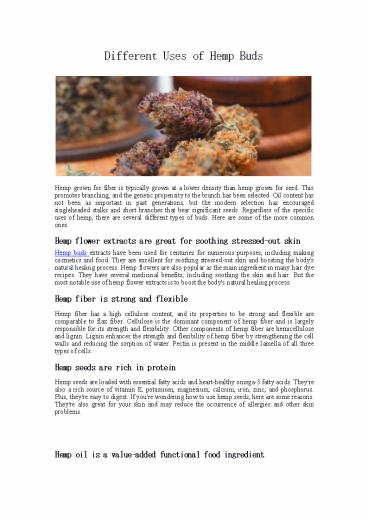Different Uses of Hemp Buds - PowerPoint PPT Presentation
Title:
Different Uses of Hemp Buds
Description:
Different Uses of Hemp Buds – PowerPoint PPT presentation
Number of Views:18
Title: Different Uses of Hemp Buds
1
Different Uses of Hemp Buds
Hemp grown for fiber is typically grown at a
lower density than hemp grown for seed. This
promotes branching, and the genetic propensity to
the branch has been selected. Oil content has not
been as important in past generations, but the
modern selection has encouraged singleheaded
stalks and short branches that bear significant
seeds. Regardless of the specific uses of hemp,
there are several different types of buds. Here
are some of the more common ones. Hemp flower
extracts are great for soothing stressed-out
skin Hemp buds extracts have been used for
centuries for numerous purposes, including making
cosmetics and food. They are excellent for
soothing stressed-out skin and boosting the
body's natural healing process. Hemp flowers are
also popular as the main ingredient in many hair
dye recipes. They have several medicinal
benefits, including soothing the skin and hair.
But the most notable use of hemp flower extracts
is to boost the body's natural healing
process. Hemp fiber is strong and flexible Hemp
fiber has a high cellulose content, and its
properties to be strong and flexible are
comparable to flax fiber. Cellulose is the
dominant component of hemp fiber and is largely
responsible for its strength and flexibility.
Other components of hemp fiber are hemicellulose
and lignin. Lignin enhances the strength and
flexibility of hemp fiber by strengthening the
cell walls and reducing the sorption of water.
Pectin is present in the middle lamella of all
three types of cells. Hemp seeds are rich in
protein Hemp seeds are loaded with essential
fatty acids and heart-healthy omega-3 fatty
acids. They're also a rich source of vitamin E,
potassium, magnesium, calcium, iron, zinc, and
phosphorus. Plus, they're easy to digest. If
you're wondering how to use hemp seeds, here are
some reasons. They're also great for your skin
and may reduce the occurrence of allergies and
other skin problems.
Hemp oil is a value-added functional food
ingredient
2
Hemp oil has been used as a food ingredient for
more than two decades. Its pressing process
reduces carbohydrate content while increasing
protein, essential fatty acids, and other
nutrients. Hemp oil also increases total phenols,
a form of antioxidant, and its other beneficial
attributes. It has been used for various
purposes, such as animal feed, cosmetics, and
functional foods. Hemp stalks are harvested for
the stalk or seeds Before harvesting hemp stalks
for their seeds and fiber, you should know how
they are harvested. Hemp is grown for both the
stalk and the seeds. The seeds contain a high
concentration of CBD, the active ingredient in
CBD products. However, hemp is most commonly
grown for its fiber, used in clothing, paper, and
textiles. Plant the stalks close together and
choose the tallest ones for the best harvesting
results to maximize yield. Harvesting hemp stalks
for fiber is less precise than other methods, but
yields can be high if you do it right. Hemp fiber
is used for paper and cardboard In addition to
being an extremely versatile crop, hemp can be
used for pulp production. The industrial pulp
industry uses trees to make paper and cardboard,
and the demand for these products has led to the
destruction of vast tracts of forests in
developing countries. Hemp fiber can be processed
into pulp and used to make paper and cardboard,
and other commodities. Hemp paper is currently
used to produce about 90 of the world's
cigarette paper.









![The Best CBD Bud and High CBD Strains [2022] - swisscbdbuds PowerPoint PPT Presentation](https://s3.amazonaws.com/images.powershow.com/9781627.th0.jpg?_=20220721052)





















